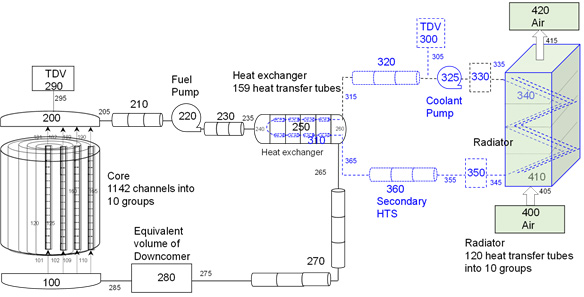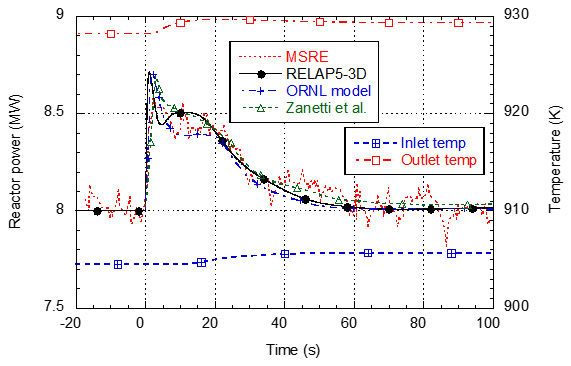Corrected errors in the reactivity insertion experiment report (in 1970) for the molten salt reactor MSRE
- Pave the way for future analysis code verification -
2022.02.08
Highlights
- Corrected an error in the report of the reactivity input experiment conducted in the molten salt reactor.
- Explain in detail why the report is incorrect.
- Neutronics and thermal-hydraulics coupling analysis with modified values using system code was performed and good agreement was obtained.
Summary
The author examined the problem that the experimental results conducted using a molten salt reactor MSRE at Oak Ridge National Laboratory (ORNL) in the U.S. could not be reproduced when neutronics and thermal-hydraulics coupling analysis was conducted, and found that there was a mistake in the experimental analysis report. It is clarified why it is wrong and how it was wrong, and the analysis under the condition that the mistake was corrected is performed, and the experimental results can be reproduced. As a result, the analysis code which could be used for the design of the molten salt reactor has been validated.
Background
In the 1960s, the Molten Salt Reactor Experiment (MSRE), operated at ORNL, conducted an experiment to apply the reactivity to the reactor by withdrawing a control rod during power operation. The reactor power during the experiment temporarily increased immediately after the reactivity insertion, but the reactor power decreased to the initial power by intrinsic characteristics of the nuclear reactor and settled down. Such characteristics are not found in currently operated reactors such as light water reactors, and are inherent safety characteristics in molten salt reactors. This experimental result is a very important result, and the test results carried out at 1, 5, and 8 MW have been published as the ORNL report. When the experimental results were analyzed with the analysis code, it was possible to reproduce only at 5MW, and the behavior of 1MW and 8MW could not be reproduced for some reason. For this reason, there are a few researchers reporting on the results of this important experiment at international conferences, and extremely abnormal conditions have continued for more than 50 years. Currently, worldwide competition for the development of molten salt reactors has started in each country. For this reason, it is necessary to evaluate the accuracy of the analysis code for evaluating the characteristics of the reactor, and the reactivity insertion test conducted by ORNL will be the focus of attention. The motivation of the research is that it was thought that the development of the molten salt reactor would be boosted if the problem which was not able to be reproduced was solved. When the experimental analysis was actually performed with a system code, the experimental results other than 5 MW could not be reproduced as in the results of the researchers up to now. Therefore, the author considered the cause of such a situation. Focusing on the fact that three kinds of experiments were conducted, the author wondered if a young researcher in a hurry might have mistaken the order of the list. When the table of the magnitude of the reactivity described for the three levels of reactor powers was listed in the power order, it was considered that the power was wrong in either the order of the largest or the smallest. This corresponds to replacing the magnitude of the input reaction degree of 1 MW and 8 MW.
Result
For the analysis, the RELAP5-3D code, which is famous as a system code for light water reactors, was used. In order to use this code, thermophysical properties such as fluid density, viscosity, thermal conductivity, and specific heat are required, and an equation as a function of temperature is derived from the composition of the molten fuel and conventional physical property value studies. After that, the thermophysical property values of the molten salt were generated using the analysis code provided by the Idaho National Laboratory. Figure 1 illustrates a computational model that simulates the heat transport systems of MSRE. It is necessary to faithfully model the heat transport system of a nuclear reactor from the core to the cooler that cools the air. When the neutronics and thermal-hydraulics coupling analysis was actually performed by exchanging the reactivity, it was found that all the experimental results could be analyzed in good agreement. Figure 2 illustrates the results of an experimental analysis at 8 MW reactor power, which many researchers have failed to analyze. Up to now, the result of Zanetti et al., who conducted the analysis assuming the similar thing as the author, are also depicted. The ORNL model is an analysis performed by ORNL after the experiment using a computer, and since the analysis is performed under a condition where the reactivity is not mistaken, the experimental results can be explained naturally.

Fig. 1 Analysis model of MSRE using the RELAP5-3D code.

Fig. 2 Comparison of experimental results and present analysis result when a stepwise reactivity of 13.0 pcm δk / k is applied at 8 MW reactor power.
Journal information
- Journal :
- Nuclear Engineering and Design, 389, (2022), 111669.
- Title:
- Validation of neutronics and thermal-hydraulics coupling model of the RELAP5-3D code using the MSRE reactivity insertion tests
- Author :
- Hiroyasu MOCHIZUKI
(Laboratory for Zero-Carbon Energy, Institute of Innovative Research, Tokyo Institute of Technology)

